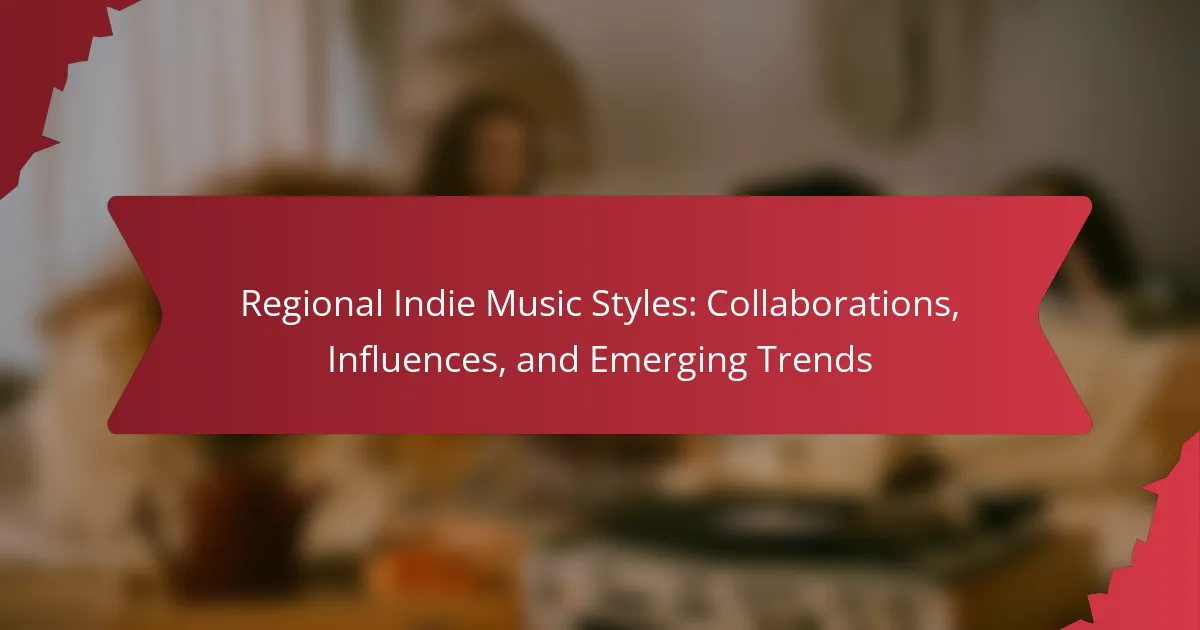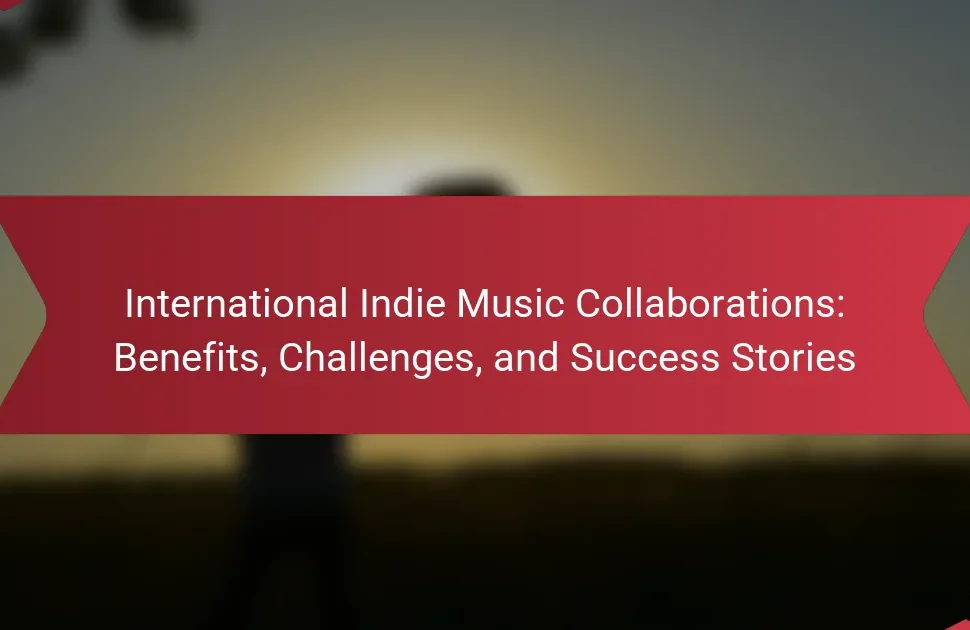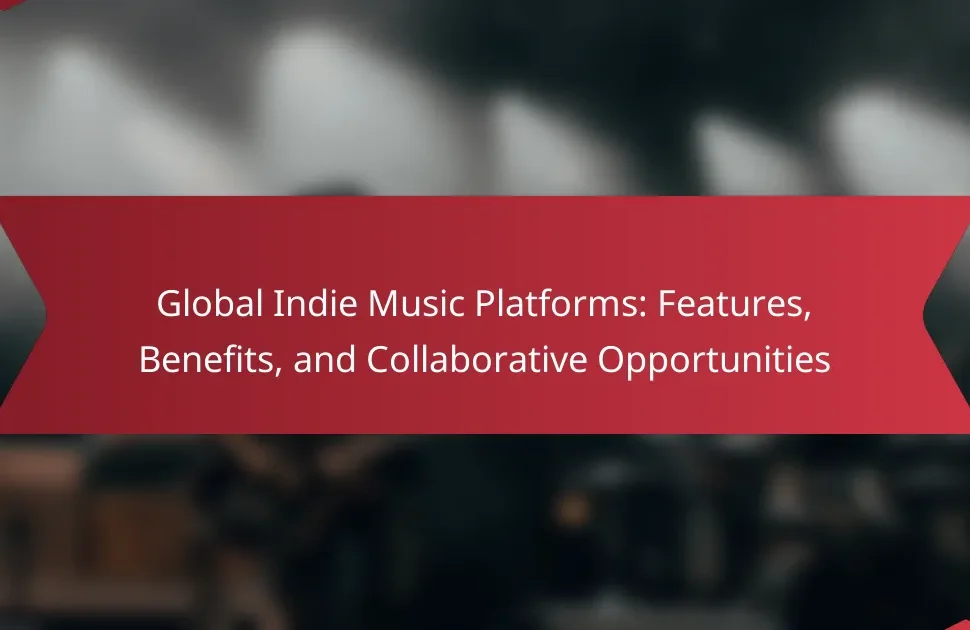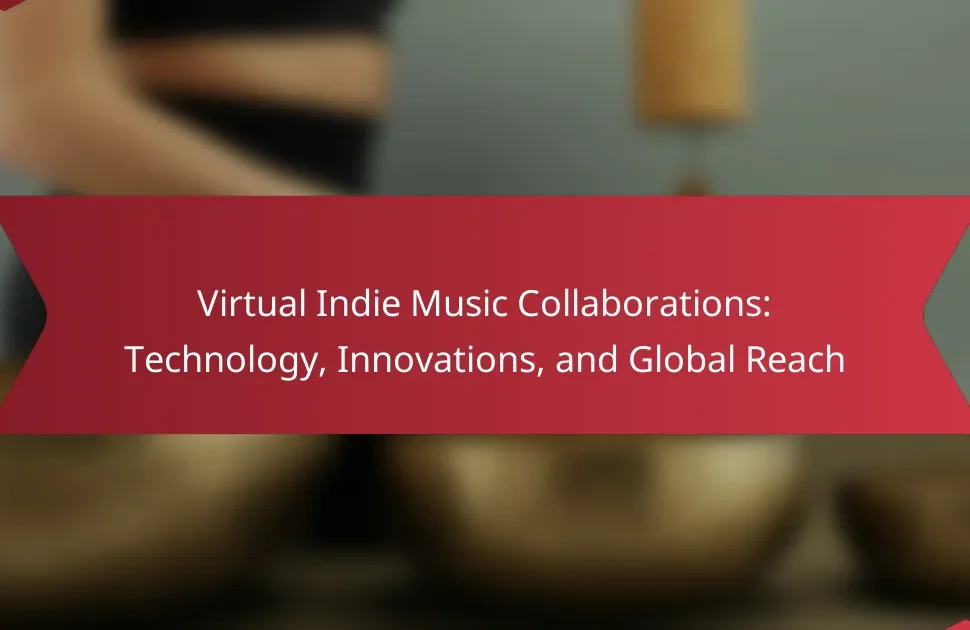Regional indie music styles are shaped by local influences and collaborative efforts that create unique sounds. This article explores the impact of collaborations, the fusion of genres, and emerging trends in the indie scene. It highlights the role of digital innovation and community support in fostering creativity among artists. Additionally, it addresses the challenges faced by regional musicians and effective marketing strategies to enhance their visibility.
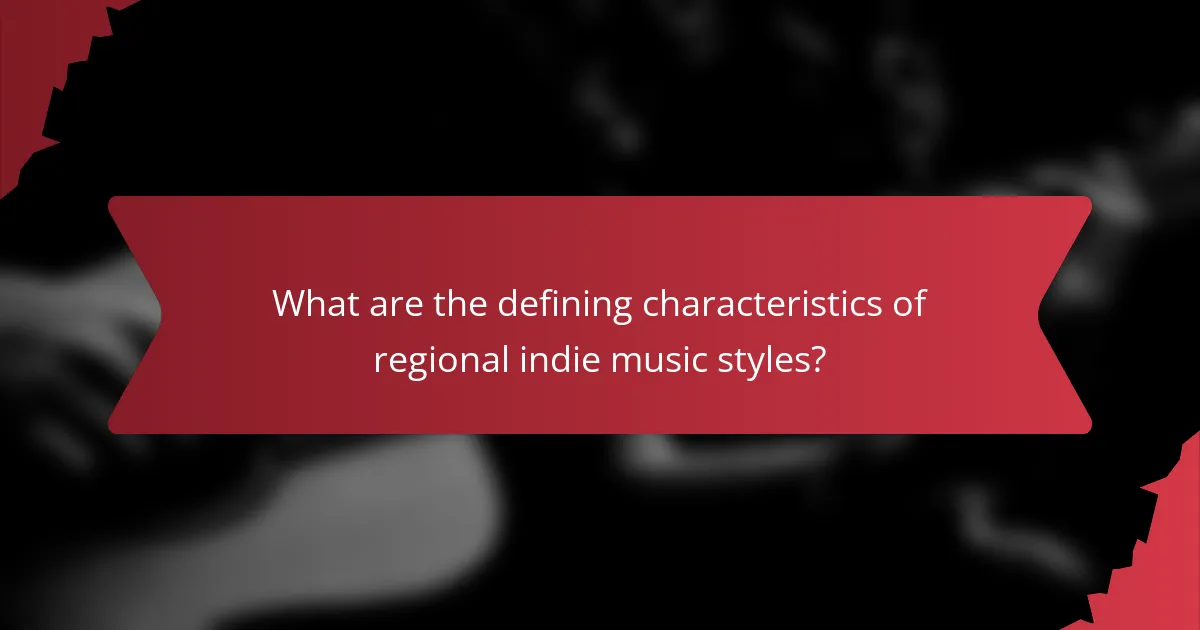
What are the defining characteristics of regional indie music styles?
Regional indie music styles are defined by their local influences, unique sounds, and collaborative efforts. These styles often blend traditional elements with contemporary genres, creating a distinct musical identity. For example, the folk-infused indie sounds of the Pacific Northwest contrast sharply with the electronic influences found in urban centers like New York. Emerging trends highlight the fusion of genres and the rise of online collaborations, showcasing diverse musical expressions. This evolution reflects the community-driven nature of regional scenes, where local artists support each other’s growth.
How do cultural influences shape regional indie music?
Cultural influences significantly shape regional indie music by infusing local traditions, languages, and social narratives. These factors create unique sounds and styles that reflect the community’s identity. For example, folk elements in Appalachian indie music highlight storytelling traditions. Globalization also plays a role, as artists blend local styles with international genres, leading to innovative collaborations. Emerging trends often stem from these cultural intersections, showcasing how diverse influences can evolve the indie music landscape.
What role do local instruments play in regional indie music?
Local instruments play a crucial role in shaping regional indie music by adding unique sounds and cultural authenticity. These instruments often reflect the local heritage and musical traditions, influencing the style and character of the music. For example, the use of traditional string instruments can create distinctive melodies that resonate with local audiences. Additionally, collaborations between artists using local instruments foster a rich blend of genres, leading to innovative sounds and emerging trends in the indie music scene. This integration of local elements enhances the overall listening experience and promotes cultural preservation within the music community.
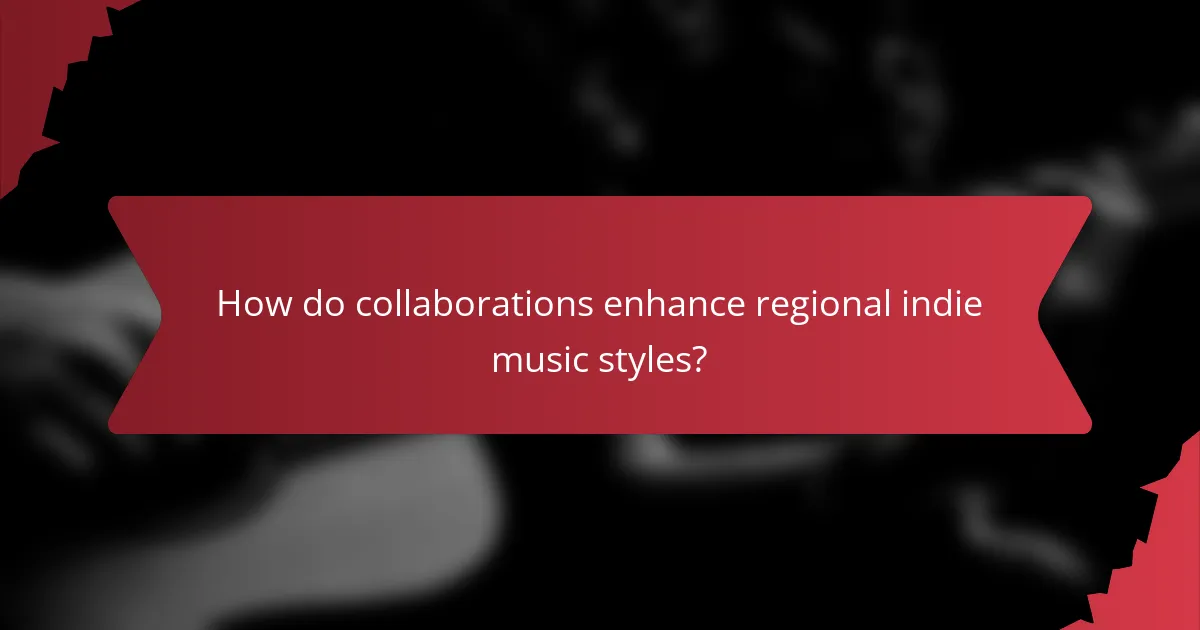
How do collaborations enhance regional indie music styles?
Collaborations significantly enhance regional indie music styles by blending diverse influences and fostering creativity. They create unique sounds that reflect local culture while attracting wider audiences. Collaborative projects often lead to innovative genre fusions, enriching the music landscape. For example, partnerships between artists in different regions can introduce fresh rhythms and lyrical themes, driving emerging trends. This dynamic exchange not only strengthens community ties but also elevates the visibility of indie music on larger platforms.
Which artists are known for cross-regional collaborations?
Artists known for cross-regional collaborations include Bon Iver, who partnered with Nigerian artist Sufjan Stevens, and the collaboration between the British band Coldplay and the Colombian singer Shakira. These artists blend diverse regional influences, enriching the global indie music scene. Other notable examples are the collaborations of the American band Fleet Foxes with various international musicians, showcasing unique sounds and styles. Such partnerships highlight the growing trend of merging regional indie music styles across borders.
What are the benefits of collaborating across genres?
Collaborating across genres enhances creativity, broadens audience reach, and fosters innovation. It allows artists to blend diverse influences, resulting in unique sounds. This cross-pollination can attract fans from different genres, expanding market potential. Collaborations often lead to fresh trends that can redefine regional indie music styles.
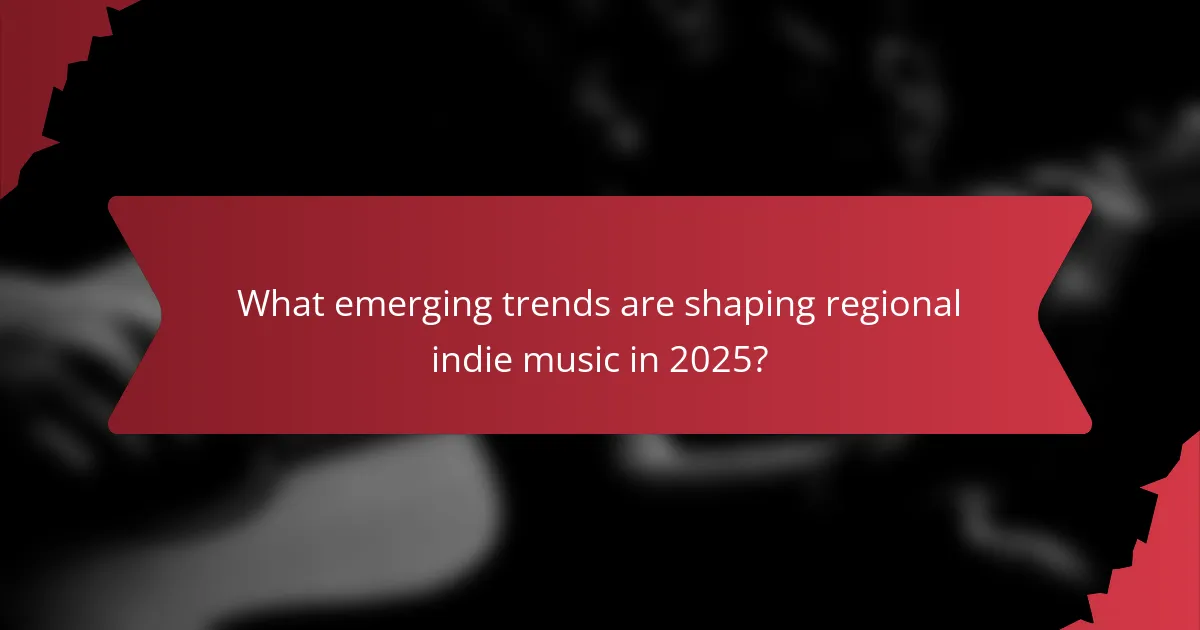
What emerging trends are shaping regional indie music in 2025?
Regional indie music in 2025 is shaped by diverse collaborations, genre-blending, and digital innovation. Artists increasingly merge traditional sounds with modern influences, creating unique regional styles. For example, the integration of local folk elements with electronic music enhances authenticity. Collaborative projects across borders expand audiences and foster creativity. Additionally, platforms like social media facilitate grassroots movements, allowing emerging artists to gain visibility. This trend of community-driven music cultivates a rich tapestry of regional identities within the indie scene.
How is technology influencing the production of regional indie music?
Technology significantly shapes regional indie music production by enabling collaboration, broadening influences, and fostering emerging trends. Digital platforms facilitate connections among artists, allowing them to share resources and ideas regardless of geographical barriers. This interconnectedness leads to innovative soundscapes that blend diverse regional styles.
Moreover, advancements in recording technology empower indie musicians to produce high-quality music independently, reducing reliance on traditional labels. Online distribution channels enable artists to reach global audiences, increasing exposure for regional sounds. As a result, the fusion of local influences with global trends creates a dynamic landscape in regional indie music.
The rise of social media further amplifies this effect, as artists can promote their work and engage with fans directly. This interaction cultivates a community around regional indie music, fostering a supportive environment for emerging talents.
In summary, technology not only enhances production capabilities but also transforms how regional indie music is created, shared, and experienced, highlighting the unique attributes of local cultures.
What role do social media platforms play in promoting regional indie artists?
Social media platforms significantly enhance the visibility of regional indie artists. They provide tools for direct engagement, allowing artists to connect with local audiences and share their unique music styles.
Platforms like Instagram and TikTok facilitate collaborations among artists, fostering a community that celebrates diverse influences. Emerging trends often gain traction through viral challenges or shared content, amplifying regional sounds and styles.
Data shows that artists utilizing social media effectively can increase their following by up to 300% within a few months, showcasing its role in promoting indie music. This growth highlights the importance of digital presence in the evolving music landscape.
Additionally, social media analytics help artists understand audience preferences, enabling them to tailor their content and enhance their reach. This feedback loop is crucial for indie artists navigating the competitive music industry.
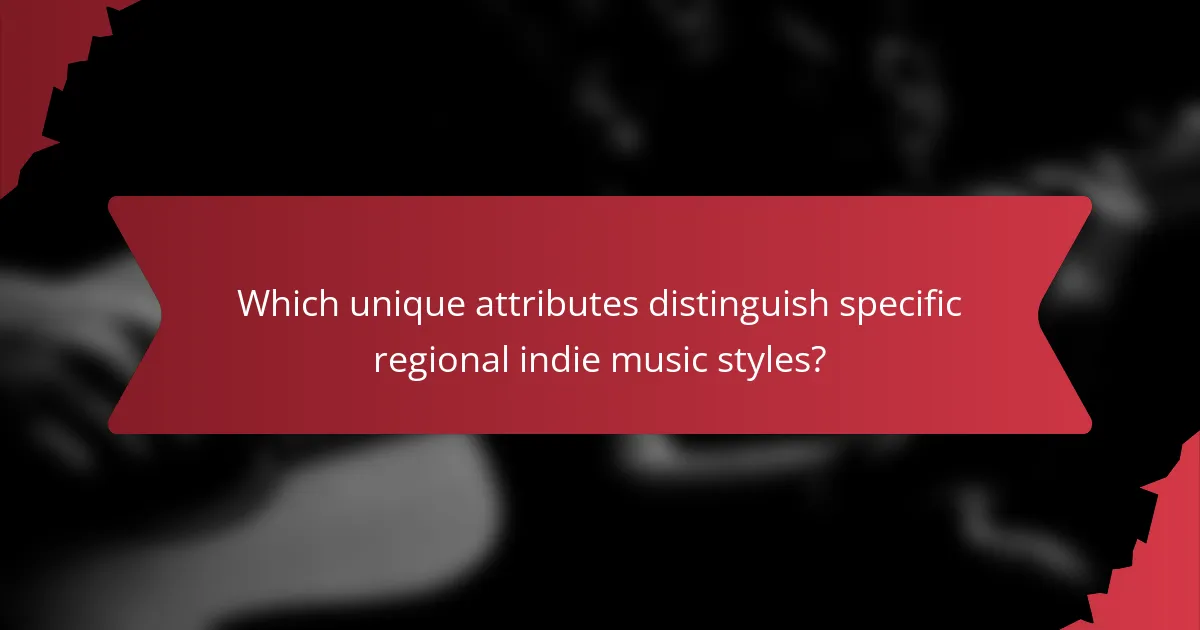
Which unique attributes distinguish specific regional indie music styles?
Unique attributes that distinguish specific regional indie music styles include local cultural influences, instrumentation variations, and lyrical themes. For example, West Coast indie often incorporates surf rock elements, while Southern indie blends folk traditions. These attributes create distinct sounds that reflect the region’s identity and history. Emerging trends show a fusion of styles, with artists collaborating across regions, further enriching the indie music landscape.
How do lyrical themes vary across different regional indie music?
Lyrical themes in regional indie music reflect local cultures, experiences, and social issues. Each region infuses its music with unique narratives, influenced by history and community values. For example, Southern indie music often explores themes of resilience and tradition, while Pacific Northwest sounds may focus on nature and introspection. Collaborations between artists from different regions can lead to innovative blends of lyrical styles, enriching the overall indie music landscape. Emerging trends show a growing interest in storytelling that resonates with specific regional identities, creating a diverse tapestry of themes across the genre.
What are some notable regional indie music festivals and their impact?
Notable regional indie music festivals significantly impact local music scenes by fostering collaboration, showcasing emerging trends, and influencing styles. Festivals like South by Southwest in Texas and Pitchfork Music Festival in Chicago highlight diverse indie sounds and create networking opportunities. These events often feature local artists alongside established acts, enhancing visibility and encouraging genre-blending. The unique atmosphere of regional festivals cultivates community engagement, driving local music economies and inspiring new creative directions. As a result, these festivals play a crucial role in shaping the future of indie music.
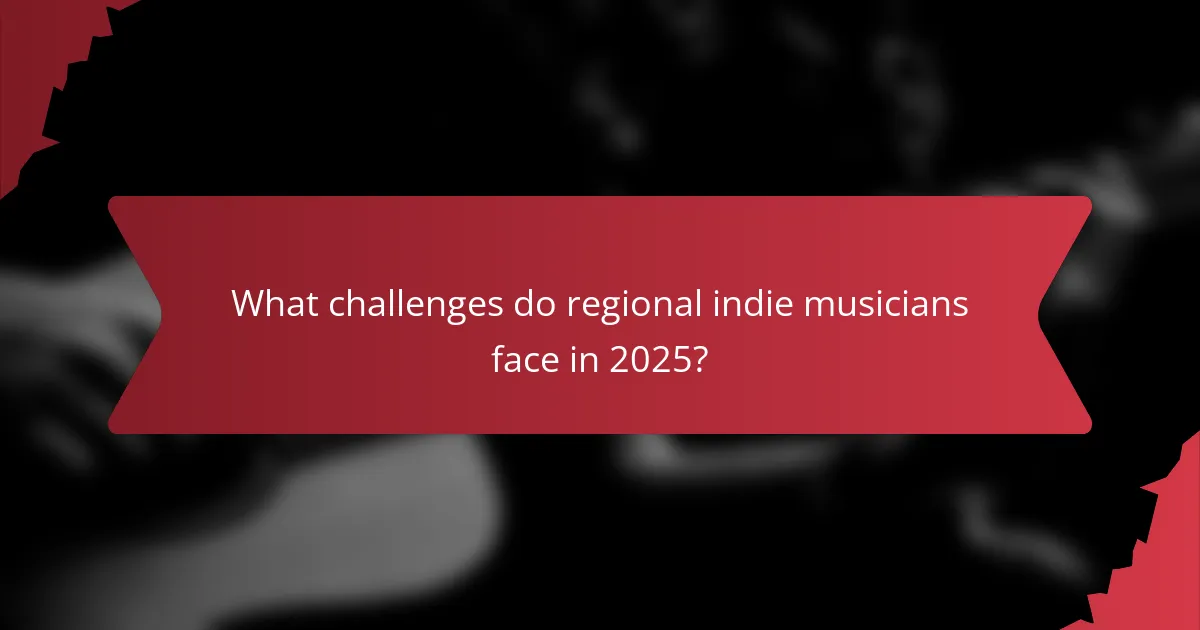
What challenges do regional indie musicians face in 2025?
Regional indie musicians face significant challenges in 2025, including limited access to funding, competition from mainstream artists, and difficulties in reaching wider audiences. These obstacles hinder their ability to innovate and collaborate effectively.
Funding remains a critical issue, as many regional artists rely on grants and sponsorships that are increasingly scarce. Additionally, the rise of digital platforms has intensified competition, making it harder for indie musicians to stand out.
Geographic isolation can also limit networking opportunities, restricting collaborations with other artists and industry professionals. As a result, regional indie musicians must navigate a complex landscape to thrive in their careers.
Emerging trends indicate that artists are increasingly turning to online communities for support, fostering a sense of collaboration despite physical distances. This shift may help mitigate some challenges by creating new avenues for exposure and partnership.
How do economic factors affect the sustainability of regional indie music?
Economic factors significantly influence the sustainability of regional indie music by affecting funding, audience reach, and market viability. Economic downturns can reduce disposable income, limiting concert attendance and music purchases. Additionally, local economies impact the availability of venues and support for artists. For instance, regions with thriving economies often see a greater investment in local music scenes, fostering collaborations and emerging trends. Moreover, economic stability can enhance access to resources such as recording studios and marketing, which are vital for indie artists.
What are common misconceptions about regional indie music?
Common misconceptions about regional indie music include the belief that it lacks diversity and innovation. In reality, regional indie music is rich in unique influences and collaborations that reflect local cultures. Many assume it is only for niche audiences, but its appeal is growing globally. Additionally, some think that indie music is solely acoustic or folk-based, overlooking the genre’s incorporation of electronic and experimental elements.

How can artists effectively market their regional indie music?
Artists can effectively market their regional indie music by leveraging collaborations, local influences, and emerging trends. Collaborations with regional artists can enhance exposure and create a unique sound. Engaging with local cultural elements can resonate with audiences, fostering a deeper connection.
Emerging trends, such as integrating digital platforms and social media, allow artists to reach wider audiences. Utilizing platforms like Bandcamp and SoundCloud can showcase their work to niche markets. Additionally, participating in local music festivals can provide valuable networking opportunities and live performance experience.
To maximize impact, artists should focus on authentic storytelling that reflects their regional influences. This approach can differentiate them in a crowded market and attract dedicated fans. By embracing these strategies, artists can effectively promote their music while staying true to their roots.
What strategies work best for promoting regional indie music?
Collaborative efforts, local events, and digital marketing are effective strategies for promoting regional indie music. Collaborations with local artists enhance visibility and create unique sounds. Hosting live events fosters community engagement and showcases talent. Utilizing social media platforms allows for targeted outreach and audience growth. Engaging with influencers can amplify reach and credibility. These strategies leverage the unique cultural attributes of regional indie music, driving interest and support.
What are the best practices for engaging with local audiences?
Engaging with local audiences in regional indie music requires authentic connections and community involvement.
1. Collaborate with local artists to blend styles and reach wider audiences.
2. Attend community events to understand local culture and preferences.
3. Utilize social media to share local stories and highlight regional influences.
4. Offer workshops or open mics to encourage participation and showcase talent.
What common mistakes should regional indie musicians avoid?
Regional indie musicians should avoid common mistakes such as neglecting collaboration opportunities, underestimating local influences, and failing to adapt to emerging trends.
First, overlooking collaboration can limit creativity and exposure. Engaging with other artists can lead to innovative sounds and broader audiences.
Second, ignoring local influences may disconnect musicians from their community. Regional sounds can enhance authenticity and resonate more with local listeners.
Lastly, resisting emerging trends can hinder relevance. Staying informed about industry shifts ensures that musicians remain competitive and appealing to evolving audiences.
